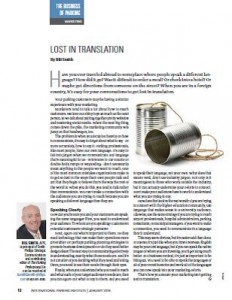Have you ever traveled abroad to someplace where people speak a different language? How did it go? Was it difficult to order a meal? Or check into a hotel? Or maybe get directions from someone on the street? When you are in a foreign country, it’s easy for your conversations to get lost in translation.Your parking customers may be having a similar experience with your marketing.
Marketers tend to talk a lot about how to reach customers. We love our shiny toys as much as the next person, so we talk about putting together pretty websites and mastering social media. When the next big thing comes down the pike, the marketing community will jump on that bandwagon, too.
The problem is when you focus too heavily on how to communicate, it’s easy to forget about what to say—or more accurately, how to say it. Parking professionals, like most people, have our own language. It’s easy to fall into jargon when we communicate. But language that’s meaningful to us—references to car counts or double-helix ramps or wayfinding—don’t necessarily mean anything to the people we want to reach. One of the most common mistakes organizations make is to get so lost in the ways their own people talk and act that they begin to believe that’s the way the rest of the world is. When you do this, you tend to talk rather than communicate. You can’t make a connection with the audiences you are trying to reach because you are speaking a different language than they are.
Speaking Clearly
How can you be sure you and your customers are speaking the same language? First, you need to understand your audience. To whom are you speaking? Customers? Potential customers? Strategic partners?
Next, figure out what’s important to them. Do they need technology that can make their operations more profitable? Or perhaps parking planning strategies to promote business development? Or do they need better design ideas? The next step in communicating effectively is understanding exactly what those needs are. And it’s not a matter of you deciding what they need and telling them; you need to see their needs through their eyes.
Finally, when you understand who you need to reach and what each of your target audience’s needs are, then you can
figure out what to say to them. But you need to speak their language, not your own. What does that mean? Well, don’t use industry jargon. Not only is it meaningless to those who work outside the industry, but it can actually undermine your efforts to connect. Don’t make your audiences have to work to understand what you are trying to say.
How does that look in the real world? If you are trying to connect with the higher-education community, use language that makes sense to a university audience. Likewise, use the same strategy if you are trying to reach airport professionals, hospital administrators, parking consultants, or municipal managers. If you want to make a connection, you need to communicate in a language they’ll understand.
This may seem obvious, but it’s easier said than done. In a sense, it’s just like when you travel overseas: English may be your first language, but if you can speak the native tongue of where you are traveling, you’ll get along much better. In a business context, it’s just as important to be bilingual. You need to be able to speak the languages of all of your constituencies and work all of the languages you can now speak into your marketing
efforts.
That’s how you ensure your marketing isn’t getting lost in translation.
Bill Smith, APR, is principal of Smith-Phillips Strategic Communications and contributing editor of The Parking Professional. He can be reached at bsmith@smith-phillips.com or 603.491.4280.
TPP-2016-01-Lost In Translation

